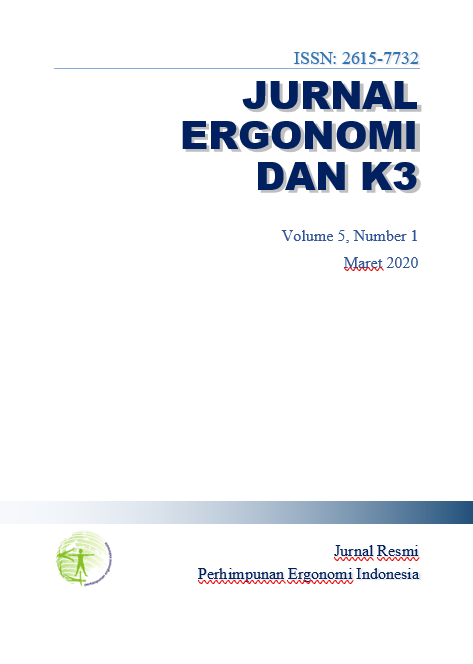The Usefulness of Neurobehavioral Task as Driver’s Fatigue Detection Technology
Abstract
Fatigue is a significant contributor to motor-vehicle accidents and fatalities. The purpose of this study was to evaluate the use of neurobehavioral task (i.e. Psychomotor Vigilance Task (PVT) and Stroop Test) as fatigue detection technology of motor-vehicle drivers. Twelve male participants (M ± SD; 35.58 ± 3.58 years) were asked to drive 6-hour long into 2 trip (Bandung – Bekasi and Bekasi – Bandung). Results showed that neurobehavioral task may be useful to detect the fatigue of motor vehicle’s driver, specifically using this three parameters, i.e. PVT-M, #L, and RTCA. Mental fatigue score from SOFI had a significant correlation with those parameters. Regular check for drivers (i.e. before, during, and after the duty) using neurobehavioral task may improve the impact of FRMS implementation in Indonesia. Furthermore, PVT, as the gold standard of application using this approach, may be replaced by a shorter test, such as Stroop Test.References
Ahlstrom, C., Nyström, M., Holmqvist, K., Fors, C., Sandberg, D., Anund, A., Kecklund, G., Åkerstedt, T. Fit-for-duty test for estimation of drivers’ sleepiness level: Eye movements improve the sleep/wake predictor, Transportation Research Part C: Emerging Technologies.26 (2013) 20–32.
Balkin, T. J., Horrey, W. J., Graeber, R. C., Czeisler, C. A., & Dinges, D. F. The challenges and opportunities of technological approaches to fatigue management, Accident Analysis & Prevention. 43(2) (2011) 565–572.
Basner, M., Mollicone, D., & Dinges, D. F. Validity and sensitivity of a brief psychomotor vigilance test (PVT-B) to total and partial sleep deprivation, Acta Astronautica. 69(11-12) (2011) 949–959.
Blatter, K., Graw, P., Münch, M., Knoblauch, V., Wirz-Justice, A., & Cajochen, C. Gender and age differences in psychomotor vigilance performance under differential sleep pressure conditions, Behavioural Brain Research. 168(2) (2006) 312–317.
Collet, C., Petit, C., Priez, A., & Dittmar, A. Stroop color–word test, arousal, electrodermal activity and performance in a critical driving situation, Biological Psychology. 69(2) (2005) 195–203.
Dawson, D., Searle, A. K., & Paterson, J. L. Look before you (s)leep: Evaluating the use of fatigue detection technologies within a fatigue risk management system for the road transport industry, Sleep Medicine Reviews. 18(2) (2014) 141–152.
Dinges, D., & Powell, J. Microcomputer analyses of performance on portable, simple visual RT Task during sustained operations, Behavioral Research Methods Instrument Computational. 17 (1985) 635-655.
Gander, P., Hartley, L., Powell, D., Cabon, P., Hitchcock, E., Mills, A., & Popkin, S. Fatigue risk management: Organizational factors at the regulatory and industry/company level, Accident Analysis & Prevention. 43(2) (2011) 573–590.
Gimeno, P. T., Cerezuela, G. P., & Montanes, M. C. On the concept and measurement of driver drowsiness, fatigue and inattention: implications for countermeasures, International Journal of Vehicle Design. 42(1/2) (2006) 67.
Groover, R.J. Powerful and Feminine: How to Increase Your Magnetic Presence and Attract Attention You Want. Oakland: Deep Pacific Press (2011).
Horne, J. A., & Baulk, S. D. Awareness of sleepiness when driving, Psychophysiology. 41(1) (2004) 161–165.
Kosmadopoulos, A., Sargent, C., Zhou, X., Darwent, D., Matthews, R. W., Dawson, D., & Roach, G. D. The efficacy of objective and subjective predictors of driving performance during sleep restriction and circadian misalignment, Accident Analysis & Prevention. 99 (2017) 445–451.
MacLeod, C. M. John Ridley Stroop: Creator of a landmark cognitive task, Canadian Psychology/Psychologie Canadienne. 32(3) (1991) 521–524.
NTSC. Data Hasil Investigasi LLAJ 2010-2016. Retrieved from http://knkt.dephub.go.id/knkt/ntsc_home/Media_Release/Media%20Release%20KNKT%202016/Media%20Release%202016%20-%20IK%20LLAJ%2020161130.pdf. June 30th 2019.
Trick, L. M., Enns, J. T., Mills, J., & Vavrik, J. Paying attention behind the wheel: a framework for studying the role of attention in driving, Theoretical Issues in Ergonomics Science. 5(5) (2004) 385–424.
Walpole, R. E., Myers, R. H. Myers, S. L., & Ye, K.. Probability & Statistics for Engineers & Scientists (9th ed.). United States of America : Pearson Education Inc. (2012).
Williamson, A., Lombardi, D. A., Folkard, S., Stutts, J., Courtney, T. K., & Connor, J. L. The Link between fatigue and safety, Accident Analysis and Prevention. 43 (2011) 498-515.
Worringham, C. J., Wood, J. M., Kerr, G. K., & Silburn, P. A. Predictors of driving assessment outcome in Parkinson’s disease, Movement Disorders. 21(2) (2006) 230–235.

